Substrate Integrated Waveguide Based Cavity-Backed Circularly-Polarized Antenna for Satellite Communication
Abstract
:1. Introduction
2. Antenna Structure and Design Principles
3. Results and Discussion
4. Conclusions
Author Contributions
Funding
Data Availability Statement
Acknowledgments
Conflicts of Interest
References
- Akbar, P.R.; Tetuko, S.J.; Kuze, H. A novel circularly polarized synthetic aperture radar (CP-SAR) system onboard a spaceborne platform. Int. J. Remote Sens. 2010, 31, 1053–1060. [Google Scholar] [CrossRef]
- Latif, S.; Shafai, L. Hybrid perturbation scheme for wide angle circular polarisation of stacked square-ring microstrip antennas. Electron. Lett. 2007, 43, 1065–1066. [Google Scholar] [CrossRef]
- Qiu, L.; Zhu, L.; Xu, Y. Wideband Low-Profile Circularly Polarized Patch Antenna Using 90° Modified Schiffman Phase Shifter and Meandering Microstrip Feed. IEEE Trans. Antennas Propag. 2020, 68, 5680–5685. [Google Scholar] [CrossRef]
- Zhuang, J.; Zhang, Y.; Hong, W.; Hao, Z. A broadband circularly polarized patch antenna with improved axial ratio. IEEE Antennas Wirel. Propag. Lett. 2015, 14, 1180–1183. [Google Scholar] [CrossRef]
- Huang, J. A technique for an array to generate circular polarization with linearly polarized elements. IEEE Trans. Antennas Propag. 1986, 34, 1113–1124. [Google Scholar] [CrossRef]
- Balanis, C.A. Antenna Theory, 3rd ed.; Wiley: New York, NY, USA, 2005; pp. 984–986. [Google Scholar]
- Bang, J.; Choi, S.; Noh, J.; Lim, J.; Kim, D.; Kim, D.; Ahn, B. A New Dual Circularly Polarized Feed Employing a Dielectric Cylinder-Loaded Circular Waveguide Open End Fed by Crossed Dipoles. Int. J. Antennas Propag. 2016, 5, 1–7. [Google Scholar] [CrossRef]
- Chen, R.-S.; Huang, G.-L.; Wong, S.-W.; Al-Nuaimi, M.K.T.; Tam, K.-W.; Choi, W.-W. Bandwidth-enhanced circularly-polarized slot antenna and array under two pairs of degenerate modes in a single resonant cavity. IEEE Antennas Wirel. Propag. Lett. 2023, 22, 288–292. [Google Scholar] [CrossRef]
- Xu, F.; Ke, W. Guided-Wave and Leakage Characteristics of Substrate Integrated. IEEE Trans. Microw. Theory Tech. 2007, 53, 66–73. [Google Scholar]
- Alibakhshikenari, M.; Virdee, B.S.; Salekzamankhani, S.; Aïssa, S.; See, C.; Soin, N.; Fishlock, S.; Althuwayb, A.; Abd-Alhameed, R.; Huynen, I.; et al. High-isolation antenna array using SIW and realized with a graphene layer for sub-terahertz wireless applications. Sci. Rep. 2021, 11, 10218. [Google Scholar] [CrossRef] [PubMed]
- Choubey, P.N.; Hong, W. A wideband dual-mode SIW cavity-backed triangular-complimentary-split-ring-slot (TCSRS) antenna. IEEE Trans. Antennas Propag. 2016, 64, 2541–2545. [Google Scholar] [CrossRef]
- Alibakhshikenari, M.; Virdee, B.S.; See, C.H.; Abd-Alhameed, R.A.; Falcone, F.; Limiti, E. High-Isolation Leaky-Wave Array Antenna Based on CRLH-Metamaterial Implemented on SIW with ±30° Frequency Beam-Scanning Capability at Millimetre-Waves. Electronics 2019, 8, 642. [Google Scholar] [CrossRef]
- Wang, W.; Jin, H.; Yu, W.; Zhang, X.H.; Wu, F.; Chin, K.; Luo, G. A single-layer dual circularly polarized SIW cavity backed patch filtenna with wide axial ratio bandwidth. IEEE Antennas Wirel. Propag. Lett. 2021, 20, 908–912. [Google Scholar]
- Zhu, C.; Xu, G.; Ren, A.; Wang, W.; Huang, Z.; Wu, X. A Compact Dual-Band Dual-Circularly Polarized SIW Cavity-Backed Antenna Array for Millimeter Wave Applications. IEEE Antennas Wirel. Propag Lett. 2022, 21, 1572–1576. [Google Scholar] [CrossRef]
- Wang, X.C.; Xia, Y.J.; Yang, J.H.; Lu, W.Z. Wideband High-Gain Circularly Polarized Substrate Integrated Cavity Antenna Array for Millimeter-Wave Applications. IEEE Trans. Antennas Propag. 2023, 71, 1041–1046. [Google Scholar] [CrossRef]
- Hu, J.; Hao, Z.C.; Miao, Z.W. Design and implementation of a planar polarization-reconfigurable antenna. IEEE Antennas Wirel. Propag. Lett. 2017, 16, 1557–1560. [Google Scholar] [CrossRef]
- Zhu, C.; Xu, G.; Ding, D.; Wu, J.; Wang, W.; Huang, Z.; Wu, X. Low profile wideband millimeter wave circularly polarized antenna with hexagonal parasitic patches. IEEE Antennas Wirel. Propag. Lett. 2021, 20, 1651–1655. [Google Scholar] [CrossRef]
- Guo, Z.-J.; Hao, Z.-C.; Yin, H.-Y.; Sun, D.-M.; Luo, G.Q. Planar shared-aperture array antenna with a high isolation for millimeter-wave low Earth orbit satellite communication system. IEEE Trans. Antennas Propag. 2021, 69, 7582–7592. [Google Scholar] [CrossRef]
- Pozar, D.M. Microwave Engineering, 4th ed.; Wiley: New York, NY, USA, 2011; pp. 284–288. [Google Scholar]
- Balanis, C.A. Antenna Theory, 3rd ed.; Wiley: New York, NY, USA, 2005; pp. 843–852. [Google Scholar]
- RT/duroid® 5870/5880 High Frequency Laminates. Rogers Corporation, Printed in U.S.A., 2022; [Revised 1603 080822 Publication #92-101]. Available online: https://rogerscorp.com/-/media/project/rogerscorp/documents/advanced-electronics-solutions/english/data-sheets/rt-duroid-5870---5880-data-sheet.pdf/ (accessed on 1 January 2022).
- Toh, B.Y.; Cahill, R.; Fusco, V.F. Understanding and measuring circular polarization. IEEE Trans. Educ. 2003, 46, 313–318. [Google Scholar]
- Zhang, T.; Zhang, Y.; Hong, W.; Wu, K. Triangular ring antennas for dual-frequency dual-polarization or circular-polarization operations. IEEE Antennas Wirel. Propag. Lett. 2014, 13, 971–974. [Google Scholar] [CrossRef]

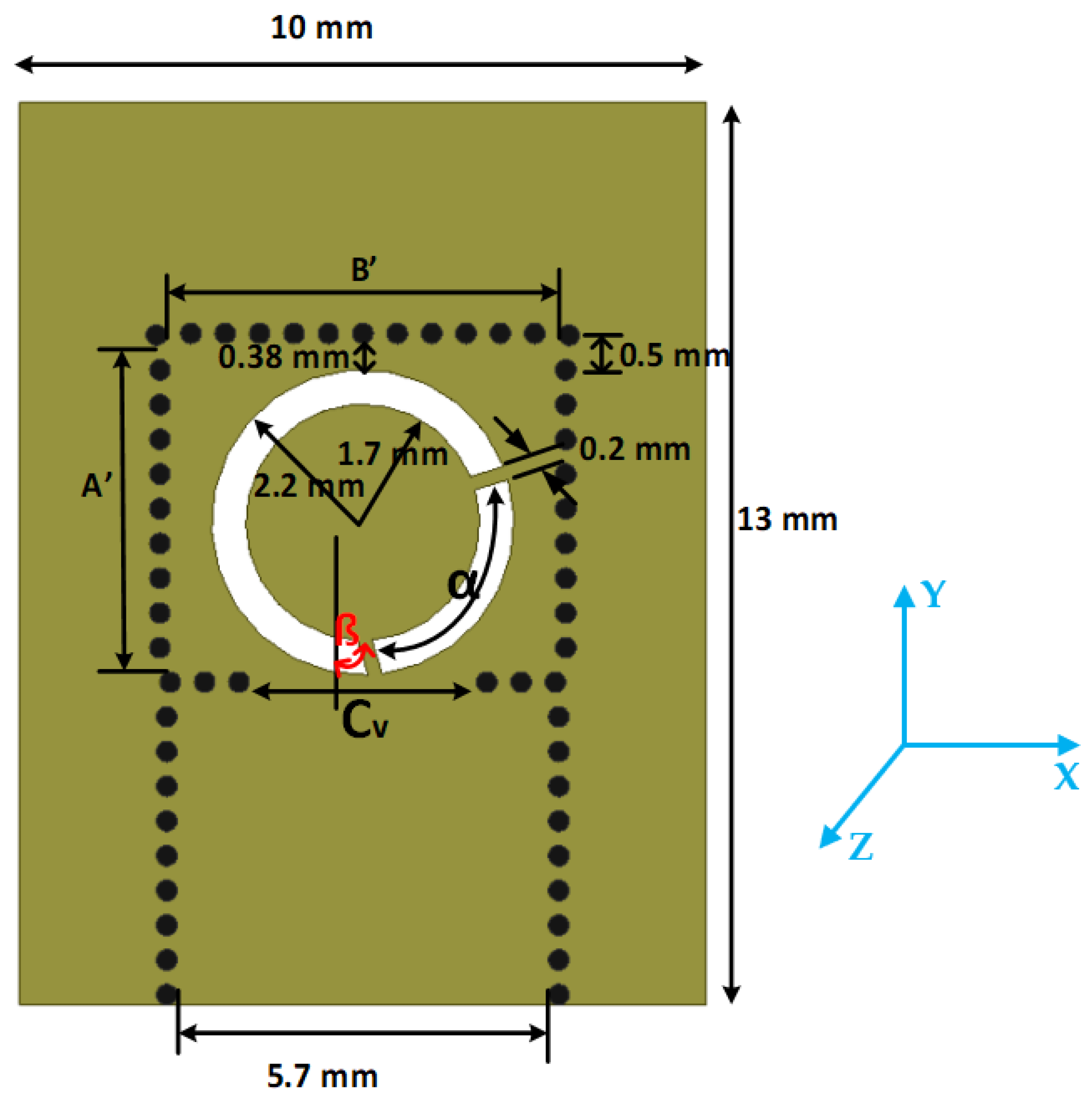
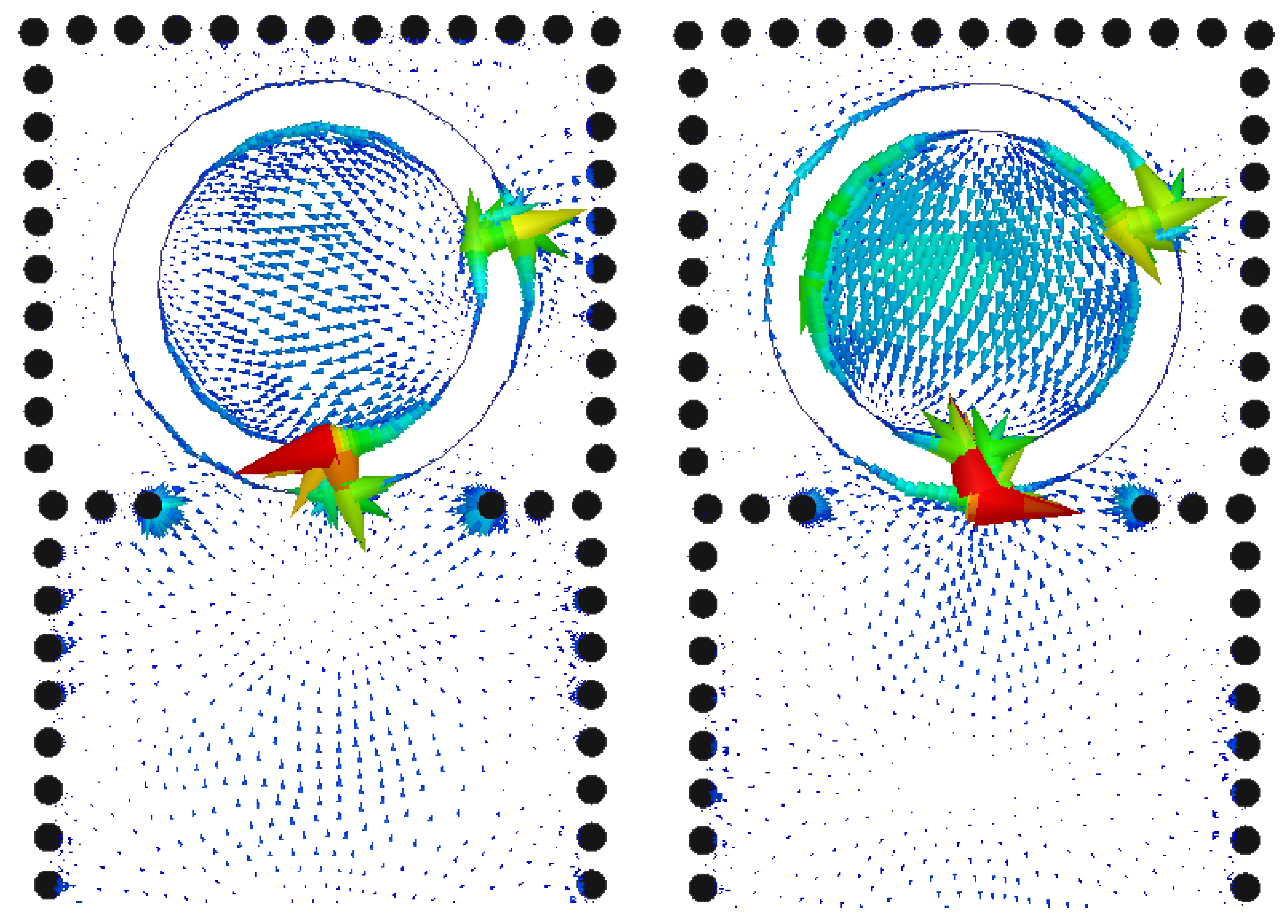
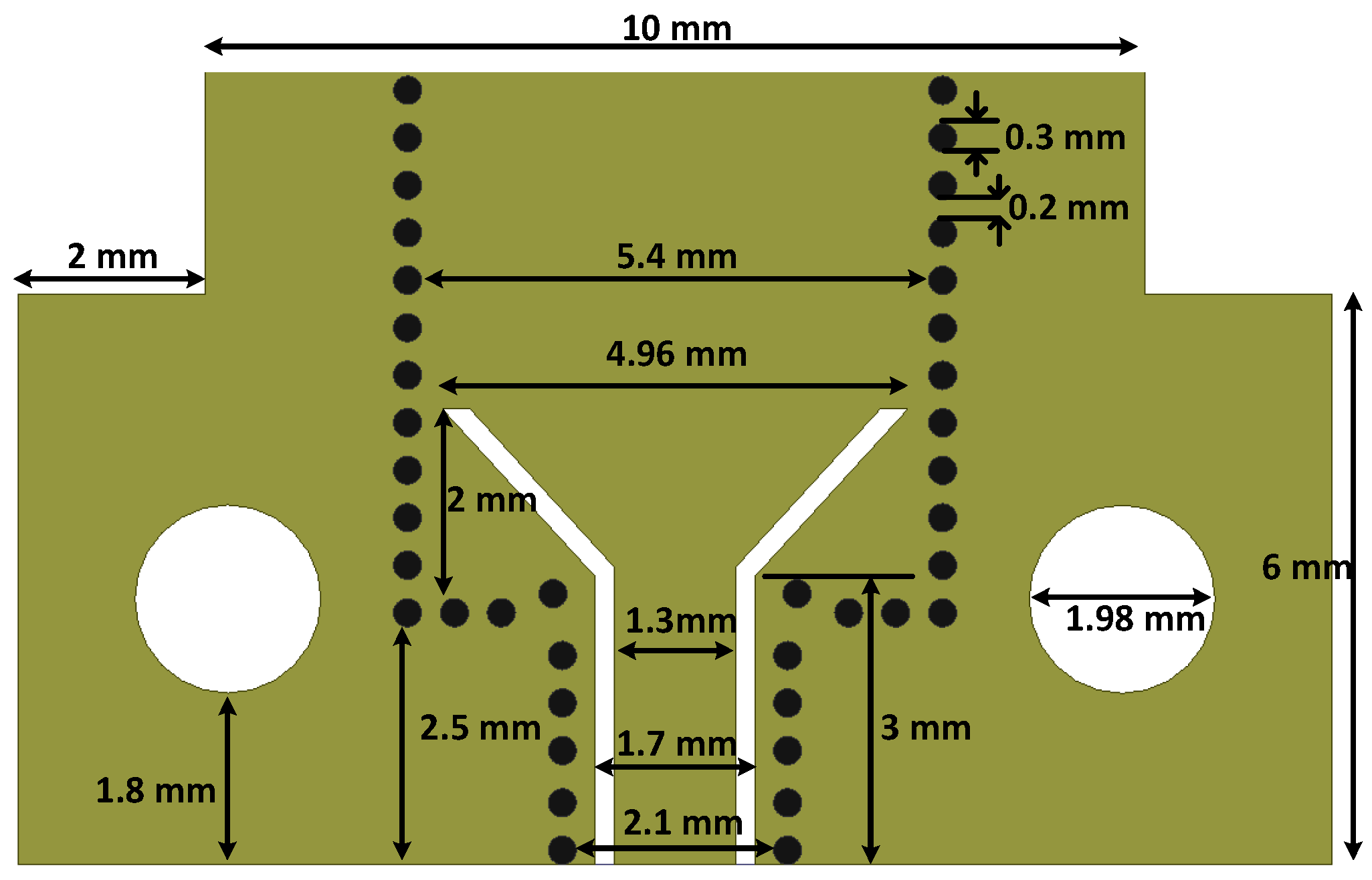

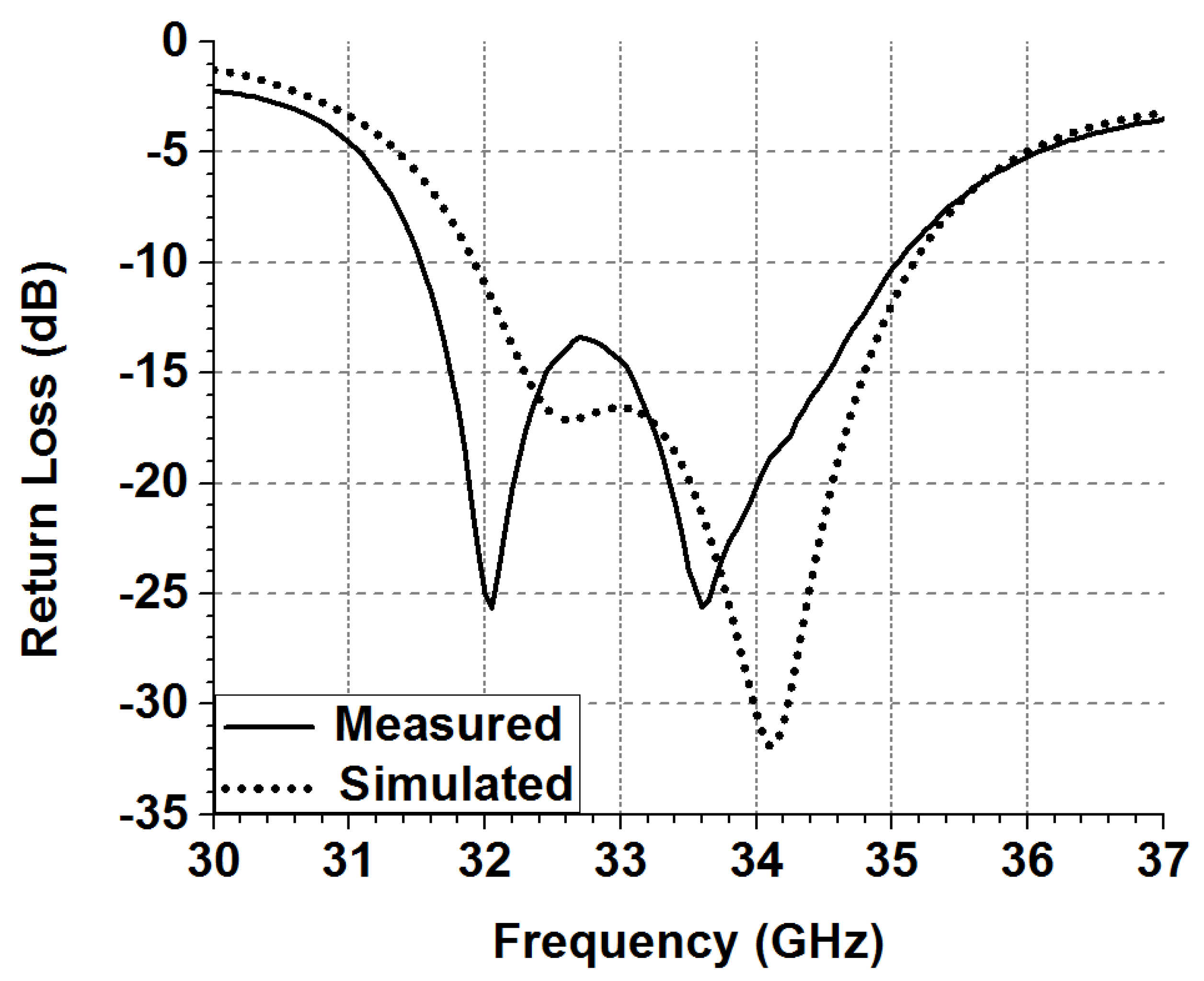
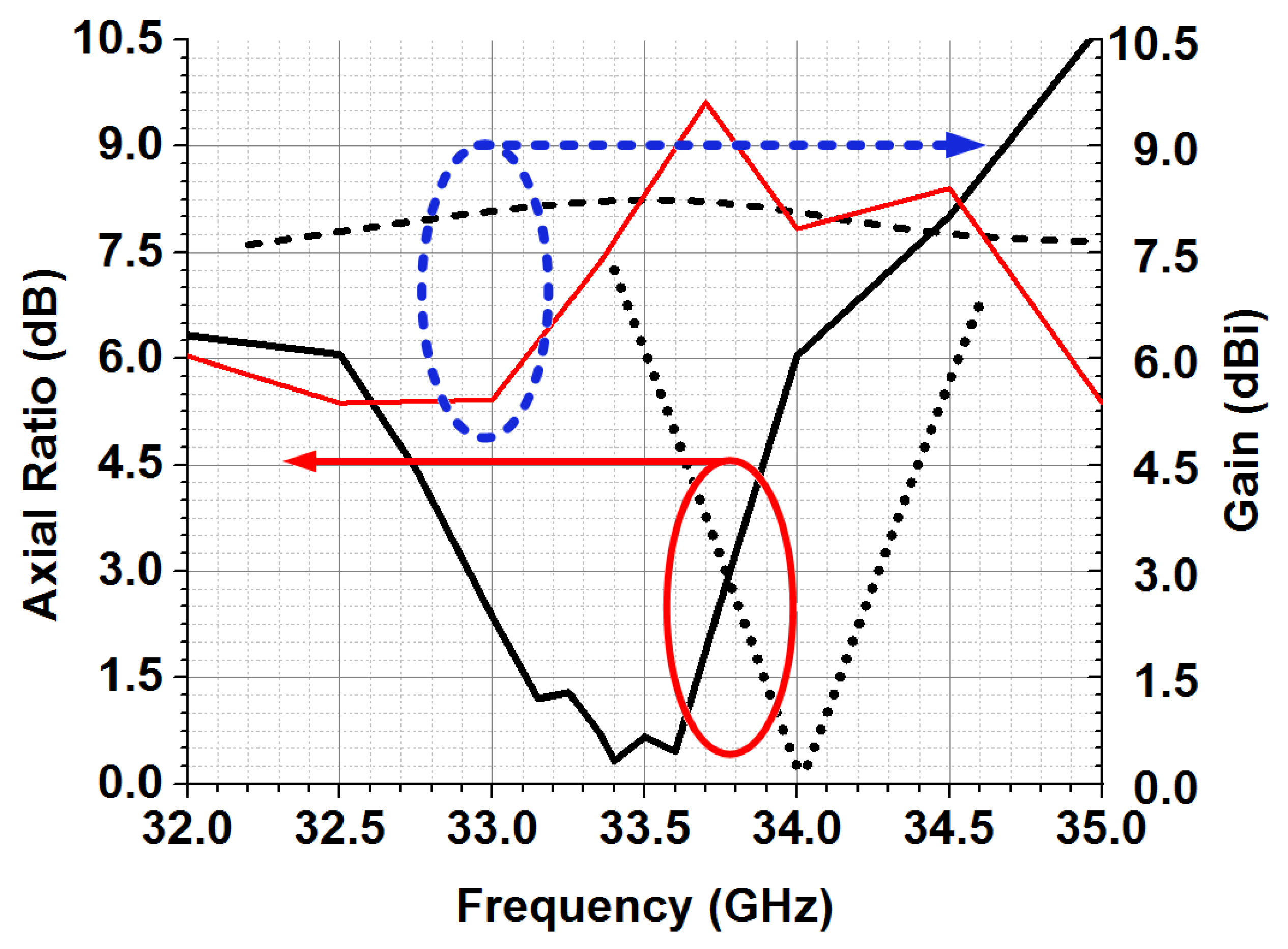

| Via Diameter | Via Separation | |||||
|---|---|---|---|---|---|---|
| 4.72 | 5.6 | 3.7 | 93°44″ | 17° | 0.3 | 0.5 |
| Reference | Frequency (GHz) | Antenna Size mm | Impedance BW % | AR BW % | Peak Gain dBi | Number of Substrate Layers |
|---|---|---|---|---|---|---|
| [14] | Dual-Band 28, 38 | SIW Cavity Size at 28 GHz 0.66 × 0.63 | 7.3, 7.5 | 2.8, 2.6 | 8, 7.9 | 3 |
| [15] | 29 | SIW Cavity Size 0.92 × 0.92 | 24.37 | 26.14 | 10.53 | 2 |
| [16] | 8.15 | No Given Data But Large | 6 | 3 | 6.16 | 1 |
| [17] | 32 | SIW Cavity Size 0.94 × 0.94 | 27.1 | 16.3 | 9 | 2 |
| This Work | 34 | 0.59 × 0.67 | 9.5 | 2.3 | 8.5 | 1 |
Disclaimer/Publisher’s Note: The statements, opinions and data contained in all publications are solely those of the individual author(s) and contributor(s) and not of MDPI and/or the editor(s). MDPI and/or the editor(s) disclaim responsibility for any injury to people or property resulting from any ideas, methods, instructions or products referred to in the content. |
© 2023 by the authors. Licensee MDPI, Basel, Switzerland. This article is an open access article distributed under the terms and conditions of the Creative Commons Attribution (CC BY) license (https://creativecommons.org/licenses/by/4.0/).
Share and Cite
Choubey, P.N.; Zhang, X.; He, T.; Hao, N.; Xu, K. Substrate Integrated Waveguide Based Cavity-Backed Circularly-Polarized Antenna for Satellite Communication. Electronics 2023, 12, 1669. https://doi.org/10.3390/electronics12071669
Choubey PN, Zhang X, He T, Hao N, Xu K. Substrate Integrated Waveguide Based Cavity-Backed Circularly-Polarized Antenna for Satellite Communication. Electronics. 2023; 12(7):1669. https://doi.org/10.3390/electronics12071669
Chicago/Turabian StyleChoubey, Prem Narayan, Xuewei Zhang, Tong He, Nan Hao, and Kuiwen Xu. 2023. "Substrate Integrated Waveguide Based Cavity-Backed Circularly-Polarized Antenna for Satellite Communication" Electronics 12, no. 7: 1669. https://doi.org/10.3390/electronics12071669






